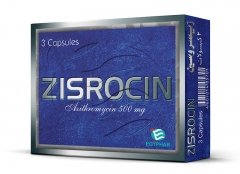CERVITAM
CORVAST 80
DAFREX
EGY DRONATE
EGYNIR
EGYURSO
FERROCAL
FINOFIB
GRAMOCEF
KOKAST 10 MG
LORAFAST
PEDICAL PLUS
RAMSOOM
VEDGE SUSPENSION
SELECTIVAL
OSTOVAL
TERVENTIN
TOTAVIT SUSPENSION
AMEBAZOLE
ARCA-ZINC
ARTHINEUR
COMBIFLOXIN
HELICURE
LODIPINE
UNOCRON 60
ZISROCIN
METHOCARBEX
ZISROCIN SUSPENSION
EGYNIR SUSPENSION
MODAZAR 100+25 MG
TOTAVIT TABLET
VEDGE TABLET
CORVAST 20
CORVAST 40
TORVAST 10
TORVAST 20
TORVAST 40
KOKAST 4 MG
UNOCRON 30
LEVOCITRONE
SHATOO
CITALOFAR
VARDARICT
ACPOPHAR
VANISH
IMMUNIPHAR
ZISROCIN


Composition
Therapeutic Indications
Posology & Method of Administration
Instructions for use
Warnings & Precautions
Pregnancy & Lactation
Drug Interaction
Undesirable Effects
Pharmacological properties
Pharmacokinetics
How supplied
Store
- Each Capsule of Zisrocin contains Azithromycin dehydrate equivalent to 500 mg Azithromycin base.



